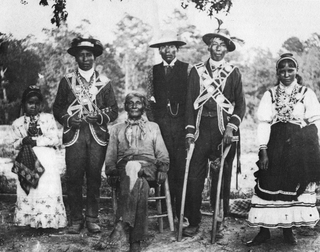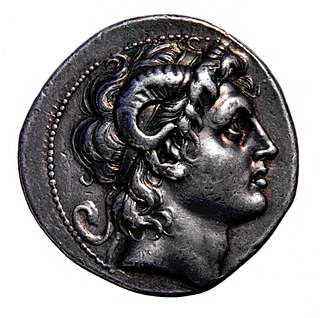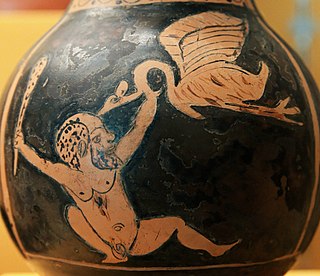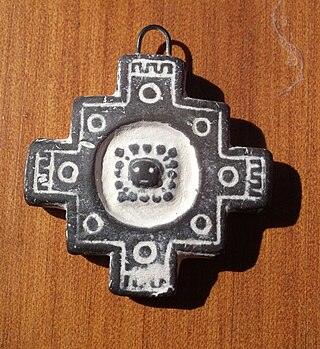Related Research Articles

Huitzilopochtli is the solar and war deity of sacrifice in Aztec mythology. He was also the patron god of the Aztecs and their capital city, Tenochtitlan. He wielded Xiuhcoatl, the fire serpent, as a weapon, thus also associating Huitzilopochtli with fire.

In Inca mythology, Mama Ocllo, or more precisely Mama Uqllu, was deified as a mother and fertility goddess. In one legend she was a daughter of Inti and Mama Killa, and in another the daughter of Viracocha (Wiraqucha) and Mama Qucha. In all of them she was the older sister and wife of Manco Cápac, whom she established the city of Cusco with. In some variations, she also bore him a son, Sinchi Roca, though all Incan rulers after Manco Cápac were believed to be their descendants.

Choctaw mythology is part of the culture of the Choctaw, a Native American tribe originally occupying a large territory in the present-day Southeastern United States: much of the states of Mississippi, Alabama, and Louisiana. In the 19th century, the Choctaw were known to European Americans as one of the "Five Civilized Tribes" even though controversy surrounds their removal.

The Hopi maintain a complex religious and mythological tradition stretching back over centuries. However, it is difficult to definitively state what all Hopis as a group believe. Like the oral traditions of many other societies, Hopi mythology is not always told consistently and each Hopi mesa, or even each village, may have its own version of a particular story, but "in essence the variants of the Hopi myth bear marked similarity to one another." It is also not clear that the stories told to non-Hopis, such as anthropologists and ethnographers, represent genuine Hopi beliefs or are merely stories told to the curious while keeping safe the more sacred Hopi teachings. As folklorist Harold Courlander states, "there is a Hopi reticence about discussing matters that could be considered ritual secrets or religion-oriented traditions."

Mythology of the Iroquois includes the creation stories and folktales of the Native Americans who formed the confederacy of the Five Nations, later the Six Nations. Historically, these stories were recorded in wampum and recited, only being written down later. In the written versions, the spellings of names differ due to transliteration and spelling variations in European languages that were not yet standardized. Variants of the stories exist, reflecting different localities and times.
The Blackfeet are a tribe of Native Americans who currently live in Montana and Alberta. They lived northwest of the Great Lakes and came to participate in Plains Indian culture.

The Indigenous peoples of the Americas comprise numerous different cultures. Each has its own mythologies, many of which share certain themes across cultural boundaries. In North American mythologies, common themes include a close relation to nature and animals as well as belief in a Great Spirit that is conceived of in various ways.

The kallikantzaros, is a malevolent goblin in Southeast European and Anatolian folklore. Stories about the kallikantzaros or its equivalents can typically be found in Greece, Bulgaria, Turkey, Serbia, Albania, Bosnia, and Cyprus. Kallikantzaroi are believed to dwell underground but come to the surface during the twelve days of Christmas, from 25 December to 6 January.

Batara Kala is the god of the underworld in traditional Javanese and Balinese mythology, ruling over it in a cave along with Setesuyara. Batara Kala is also named the creator of light and the earth. He is also the god of time and destruction, who devours unlucky people. He is related to Hindu concept of Kala, or time. In mythology, he causes eclipses by trying to eat the Sun or the Moon.

The story of Dhul-Qarnayn, is mentioned in the Quran.
The Fifth World in the context of creation myths describes the present world as interpreted by several indigenous groups in the USA and Central America. The central theme of the myth holds that there were four other cycles of creation and destruction that preceded the Fifth World. The creation story is taken largely from the mythological, cosmological, and eschatological beliefs and traditions of earlier Mesoamerican cultures.

Coyote is a mythological character common to many cultures of the Indigenous peoples of North America, based on the coyote animal. This character is usually male and is generally anthropomorphic, although he may have some coyote-like physical features such as fur, pointed ears, yellow eyes, a tail and blunt claws. The myths and legends which include Coyote vary widely from culture to culture.
The Churel, also spelled as Charail, Churreyl, Chudail, Chudel, Chuṛail, Cuḍail or Cuḍel is a mythical or legendary creature resembling a woman, which may be a demoniacal revenant said to occur in South Asia and Southeast Asia, particularly popular in India, Bangladesh, Nepal and Pakistan. The churel is typically described as "the ghost of an unpurified living thing", but because she is often said to latch on to trees, she is also called a tree-spirit. According to some legends, a woman who dies during childbirth or pregnancy or from suffering at the hands of her in-laws will come back as a revenant churel for revenge, particularly targeting the males in her family.

Turkic mythology refers to myths and legends told by the Turkic people. It features Tengrist and Shamanist strata of belief along with many other social and cultural constructs related to the nomadic and warrior way of life of Turkic and Mongol peoples in ancient times. Turkic mythology shares numerous points in common with Mongol mythology. Turkic mythology has also been influenced by other local Asiatic and Eurasian mythologies. For example, in Tatar mythology elements of Finnic and Indo-European mythologies co-exist. Beings from Tatar mythology include Äbädä, Alara, Şüräle, Şekä, Pitsen, Tulpar, and Zilant.
Spider Grandmother is an important figure in the mythology, oral traditions and folklore of many Native American cultures, especially in the Southwestern United States.

The Pygmies were a tribe of diminutive humans in Greek mythology.

Stories of miraculous births often include conceptions by miraculous circumstances and features such as intervention by a deity, supernatural elements, astronomical signs, hardship or, in the case of some mythologies, complex plots related to creation.
Myth is a folklore genre consisting of narratives that play a fundamental role in a society, such as foundational tales or origin myths. Since "myth" is popularly used to describe stories that are not objectively true, the identification of a narrative as a myth can be highly controversial. Many religious adherents believe that the narratives told in their respective religious traditions are historical without question, and so object to their identification as myths while labelling traditional narratives from other religions as such. Hence, some scholars may label all religious narratives as "myths" for practical reasons, such as to avoid depreciating any one tradition because cultures interpret each other differently relative to one another. Other scholars may abstain from using the term "myth" altogether for purposes of avoiding placing pejorative overtones on sacred narratives.

Inca mythology or religion includes many stories and legends that attempt to explain or symbolize Inca beliefs.

Bantu mythology is the system of beliefs and legends of the Bantu people of Africa. Although Bantu peoples account for several hundred different ethnic groups, there is a high degree of homogeneity in Bantu cultures and customs, just as in Bantu languages.
References
- ↑ Mercatante, Anthony S. (2009). The Facts on File encyclopedia of world mythology and legend. Internet Archive. New York : Facts On File. ISBN 978-0-8160-7311-5.
- ↑ Dixon-Kennedy, Mike (1996). Native American myth & legend : an A-Z of people and places. Internet Archive. London : Blandford. p. 76. ISBN 978-0-7137-2623-7.
- 1 2 See The Mythology of All Races, Vol. XI, p. 262 (1920)